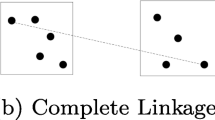Abstract
Using the equality form of the necessary and sufficient conditions introduced in Jafarizadeh (Phys Rev A 84:012102 (9 pp), 2011), minimum error discrimination between states of the two sets of equiprobable similarity transformed quantum qudit states is investigated. In the case that the unitary operators describing the similarity transformations are generating sets of two irreducible representations and the states fulfill a certain constraint, the optimal set of measurements and the corresponding maximum success probability of discrimination are determined in closed form. In the cases that they are generating sets of reducible representations, there exist no closed-form formula in general, but the procedure can be applied properly in each case provided that the states obey some constraints. Finally, we give the maximum success probability of discrimination and optimal measurement operators for some important examples of mixed quantum states, such as generalized Bloch sphere m-qubit states, qubit states and their three special cases.
Similar content being viewed by others
References
Helstrom, C.W.: Quantum Detection and Estimation Theory. Academic, New York (1976)
Holevo, A.: Probabilistic and Statistical Aspects of Quantum Theory. North-Holland, Amsterdam (1982)
Eldar, Y.C., Megretski, A., Verghese, G.C.: Designing optimal quantum detectors via semidefinite programming. IEEE Trans. Inf. Theory 49, 1007–1012 (2003)
Barnett, S.M., Croke, S.: On the conditions for discrimination between quantum states with minimum error. J. Phys. A Math. Theor. 42, 062001(4 pp) (2009)
Barnett, S.M., Croke, S.: Quantum state discrimination. Adv. Opt. Photon. 1, 238–278 (2009)
Jafarizadeh, M.A., Mazhari, Y., Aali, M.: The minimum-error discrimination via Helstrom family of ensembles and convex optimization. Quant. Inf. Process. 10, 155–176 (2011)
Hwang, W.-Y., Bae, J.: Minimum-error state discrimination constrained by the no-signaling principle. J. Math. Phys. 51, 0222022 (11 pp) (2010)
Assalini, A., Cariolaro, G., Pierobon, G.: Efficient optimal minimum error discrimination of symmetric quantum states. Phys. Rev. A 81, 012315 (4 pp) (2010)
Ivanovic, I.D.: How to differentiate between non-orthogonal states. Phys. Lett. A 123, 257–259 (1987)
Dieks, D.: Overlap and distinguishability of quantum states. Phys. Lett. A 126, 303–306 (1988)
Peres, A., Terno, D.R.: Optimal distinction between non-orthogonal quantum states. J. Phys. A 31, 7105–7112 (1998)
Jaeger, G., Shimony, A.: Optimal distinction between two non-orthogonal quantum states. Phys. Lett. A 197, 83–87 (1995)
Chefles, A.: Unambiguous discrimination between linearly independent quantum states. Phys. Lett. A 239, 339–347 (1998)
Jafarizadeh, M.A., Rezaei, M., Karimi, N., Amiri, A.R.: Optimal unambiguous discrimination of quantum states. Phys. Rev. A 77, 042314 (12 pp) (2008)
Kimura, G., Miyadera, T., Imai, H.: Optimal state discrimination in general probabilistic theories. Phys. Rev. A 79, 062306 (9 pp) (2009)
Jafarizadeh, M.A., Sufiani, R., Mazhari Khiavi, Y.: Minimum error discrimination between similarity-transformed quantum states. Phys. Rev. A 84, 012102 (9 pp) (2011)
Joshi, A.W.: Elements of group theory for physicists. New Age International (P) Limited, Publishers, New Delhi (1997)
James, G., Liebeck, M.W.: Representations and Characters of Groups. Cambridge University Press, NY (2001)
Andersson, E., Barnett, S.M., Gilson, C.R., Hunter, K.: Minimum-error discrimination between three mirror-symmetric states. Phys. Rev. A 65, 052308–4 (2002)
Samsonov, B.F.: Minimum error discrimination problem for pure qubit states. Phys. Rev. A 80, 052305–11 (2009)
Ježek, M., Řeháček, J., Fiurášek, J.: Finding optimal strategies for minimum-error quantum-state discrimination. Phys. Rev. A 65, 060301–4 (2002)
Weinberg, S.: The Quantum Theory of Fields I. Cambridge University Press, NY (1995)
Jafarizadeh, M.A., Sufiani, R.: Bell-state diagonal entanglement witnesses for relativistic and nonrelativistic multispinor systems in arbitrary dimensions. Phys. Rev. A 77, 012105 (25 pp) (2008)
Author information
Authors and Affiliations
Corresponding author
Appendix
Appendix
Here, we want to calculate maximal success probability given in Eq. (93). To this aim, first we express Eq. (13) in terms of the Bloch vectors components as
for any \(i\in S_{I}\cap S^{\prime }_{I}\). From Eqs. (95) and (88), it is seen that for any \(i\in S_{I}\cap S^{\prime }_{I}\), the signs of \(\eta bn_{i}-\eta ^{\prime }b^{\prime }n^{\prime }_{i}\) and \(m_{i}\) are opposite. In other words, if restrictions of \(\hat{n}, \hat{n}^{\prime }, \hat{m}\) and \(\hat{m}^{\prime }\) to the subspace corresponding to the index set \(S_{I}\cap S^{\prime }_{I}\) are denoted by \(\vec {n}_{0}, \vec {n}^{\prime }_{0}, \vec {m}_{0}\) and \(\vec {m}^{\prime }_{0}\) respectively, then the vectors \(\eta b\vec {n}_{0}-\eta ^{\prime }b^{\prime }\vec {n}^{\prime }_{0}\) and \(\vec {m}_{0}\) point in the opposite directions and we can write
Therefore, Eq. (96) takes the following vectorial form
Eqs. (88), (97) and (98) show that the vectors \(\vec {n}_{0}, \vec {n}^{\prime }_{0}, \vec {\beta }, \vec {m}_{0}\) and \(\vec {m}^{\prime }_{0}\) are coplanar. Next, to simplify the algebra, we choose an orthogonal coordinate system in the subspace corresponding to the index set \(S_{I}\cap S^{\prime }_{I}\) in which the plane of \(\vec {n}_{0}\) and \(\vec {n}^{\prime }_{0}\) coincides with the plane defined by an arbitrary pair of coordinate axes. Also, \(\vec {n}_{0}\) points toward the positive direction of one axis of the pair. Let us denote by \(n^{\prime }_{0}, \beta _{0}, m_{0}\) and \(m^{\prime }_{0}\) the components of \(\vec {n}^{\prime }_{0}, \vec {\beta }, \vec {m}_{0}\) and \(\vec {m}^{\prime }_{0}\) along an axis of the pair lying in the direction of \(\vec {n}_{0}\) and by \(n^{\prime }_{1}, \beta _{1}, m_{1}\) and \(m^{\prime }_{1}\) their components along another axis, respectively. In the considered coordinate system, Eq. (88) and the third relations of Eqs. (91) and (92) are written as
where we have introduced \(\mu =\sum ^{n}_{j=1}\lambda _{j}\). We square both sides of the first two relations of Eqs. (91) and (92), then sum up over \(i\) and use the fact that \(\hat{n}, \hat{n}^{\prime }, \hat{m}\) and \(\hat{m}^{\prime }\) are unit vectors, to obtain
Finally, by composing Eqs. (99)–(101) we attain to Eq. (93) for \(p_{opt}\).
Rights and permissions
About this article
Cite this article
Jafarizadeh, M.A., Khiavi, Y.M. & Kourbolagh, Y.A. Minimum-error discrimination between two sets of similarity-transformed quantum states. Quantum Inf Process 12, 2385–2404 (2013). https://doi.org/10.1007/s11128-013-0527-7
Received:
Accepted:
Published:
Issue Date:
DOI: https://doi.org/10.1007/s11128-013-0527-7




